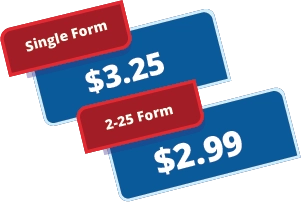E-File Form 1099-G Online with Tax2efile
The process of filing tax returns can be cumbersome, but filing your Form 1099-G for certain government payments can be easily done with Tax2efile. As an IRS-authorized e-filing service provider, we offer a seamless, secure, and user-friendly platform aimed at eliminating the stress of filing government income. Regardless of whether you are filing for unemployment compensation, state tax refunds, or any other taxable grants, we make sure that your filing is precise and timely.

What is Form 1099-G?
Form 1099-G is used to report local, state, and federal government payments made to taxpayers during a particular tax year. The filers will receive the form from the government agencies to inform the filers of their funds. They will then receive a copy that will be needed to report their federal income tax returns. It should be used to calculate the filer’s federal adjusted gross income or report the amount of refund the filer received from a prior tax year. If income is acquired from Reemployment Trade Adjustment Assistance (RTAA) payments; taxable grants, agricultural payments, or payments on a Commodity Credit Corporation (CCC) loan then it must be reported to the IRS.
Quantities that do not need to be reported on Form 1099-G, may include compensation for services, prizes, and certain incentives, these amounts may be reportable on tax returns of 1099-MISC (Miscellaneous Information), or 1099-NEC (Non-Employee Compensation). 1099-G tax returns must be mailed to recipients by February 15th and e-filed with the IRS by March 31st each year.
How to File IRS Form 1099-G Online?
Information Required to File Form 1099-G
- Taxpayer’s information
- Income information (State or Local Income Tax Refunds, Credits, or Offsets)
- Trade adjustments
- Payments from the Department of Agriculture
- Types of loans only available to farmers
As with all tax records, the filer may hold onto the form for a minimum of three years. The account number is required if the filer has multiple accounts for a recipient for whom may need to file more than one 1099-G return.


Watch our step-by-step video on How to E-File IRS Form 1099-G with Tax2efile
Who Must File Form 1099-G?
Form 1099-G must be filed when payments for the following have been made:
- Unemployment
- Income tax refunds, credits, or offsets of the state or local
- Reemployment trade adjustment assistance (RTAA) payments
- Taxable grants
- Agricultural payments
All the copies need to be completed and received by January 31st of the year followed by the tax year. If the filer knows they are a victim and already reported the fraud to the IRS, the IRS will investigate the case. However, the filler will not need to submit any additional reports to the IRS. According to the IRS rules, an individual that receives UI benefits and does not use them will still receive a 1099-G but can show the money as being paid back.
When is the Form 1099-G Deadline?
| Filing Type | Deadline |
|---|---|
| Recipient copy | January 31st |
| IRS Paper Filing | February 28th |
| IRS Electronic Filing | March 31st |
Note: If the due date/deadline falls on a Saturday, Sunday, or federal holiday, the filer will need to E-file on the next business day.
Get Started by Registering with Tax2efile Today!
Our IRS-approved e-fling services make tax season stress-free. Sign up Today!

Frequently Ask Questions
Find answers to commonly asked questions about our products and services.
A government agency would send a 1099-G to someone to inform them of funds you have received that you may need to report on your federal income tax return.
Federal, state, or local governments file this form if they made payments of: Unemployment compensation. State or local income tax refunds, credits, or offsets. Reemployment trade adjustment assistance (RTAA) payments.
Details required to file Form 1099-G are: Details are Payer Information & Tin of Payer, Recipient Information, Tin of, Recipient
Yes, Tax2efile offers a bulk upload feature that allows the user to upload all of the payers to an excel sheet for a faster process.
Tax2efile allows you to correct a mistake to the recipient’s information for TINs, Names & amounts.
Yes, many e-filing platforms, including Tax2efile, allow you to conveniently e-file Form 1099-G for multiple recipients in a single submission.
Yes, compensation for services, prizes, and certain incentives typically do not need to be reported on Form 1099-G. Instead, these amounts may be reportable on tax returns of 1099-MISC (Miscellaneous Information) or 1099-NEC (Non-Employee Compensation).
If you haven’t received your Form 1099-G by February 15th, contact the relevant government agency that should have issued the form to you. It’s crucial for accurate reporting on your federal income tax return.
Yes, if you identify an error after filing Form 1099-G, you should file an amended return promptly to correct the information. Timely corrections help avoid potential issues with your tax filings.
If you suspect fraud, report it to the IRS immediately. The IRS will investigate the case, and you may not need to submit additional reports if you’ve already reported the fraud.
Yes, Tax2efile offers printing and mailing service! Our dedicated team will print and mail out each form you filed.
Using our fast electronic service, you can complete your filing within 5 minutes.
To file Form 1099-G for a single return the filing fee is $3.25.
The IRS requires Form 1099-G to be submitted by February 28 through the mail and by March 31 if you file the form electronically however, recipients’ copy should be mailed by January 31.
Failure to file the 1099 form by the deadline may result in IRS penalties. The penalty can be from $60 per 1099 Form, the maximum penalty can be up to $630,500. If you submit Form more than 31 days to before August 1, the penalty increases to $120 per 1099 Form and maximum penalty up to $1,891,500. If you file after August 1, the penalty can be from $310 per 1099 Form and maximum penalty up to $3,783,000. Additionally, there are penalties for failure to furnish the payee statement.
Generally, you should file Form 1099-G for the appropriate tax year within the specified deadlines. Late filing may result in penalties, and it’s advisable to consult with tax professionals for guidance on specific situations.
Form 1099-G is typically issued to report various government payments, such as unemployment compensation, state tax refunds, or other government-related income. Tax2efile supports the filing of Form 1099-G for these types of payments.
If you discover an error on a filed Form 1099-G, Tax2efile provides a correction feature. You can log in to your account, select “Corrections”, and make the necessary corrections promptly.
Late filing of Form 1099-G may result in penalties imposed by the IRS. Tax2efile advises users to file their forms on time to avoid potential late fees. The specific penalty amounts can be checked on the IRS website or through Tax2efile support.
Still have questions?
If you have more questions, please refer to our FAQ page. Contact our customer support team for assistance.





